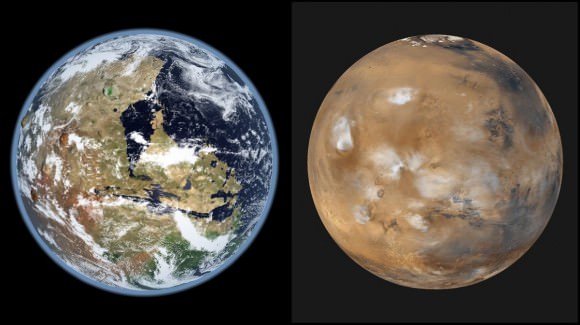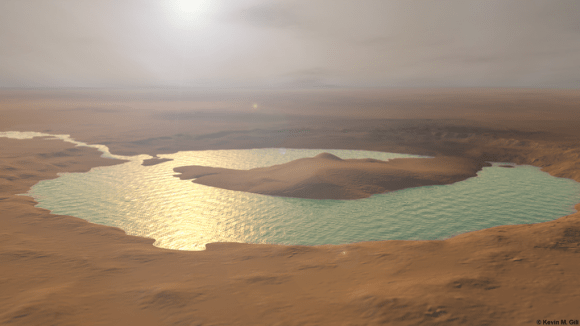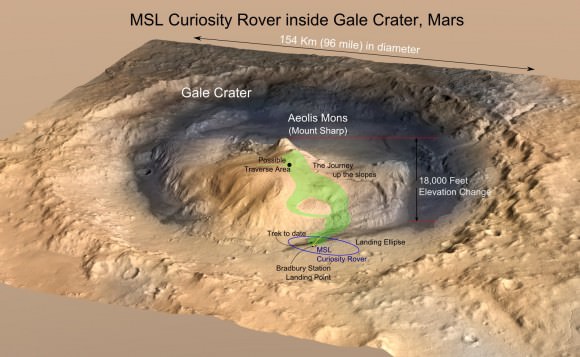It has become a well-known scientific fact that billions of years ago, Mars once had a thicker atmosphere and liquid water on its surface. Scientists have also discovered that it was the gradual loss of this atmosphere, between 4.2 and 3.7 billion years ago, that caused Mars to go from being a warmer, wetter environment to the dry, freezing environment it is today.
Despite the existence of both a thicker atmosphere and water, questions remain as to whether or not Mars was truly habitable in the past. According to a new study from a team of researchers from the Los Alamos National Laboratory (LANL), the discovery of a specific mineral (boron) has added weight to the argument that Mars was once a potentially life-bearing world.
The study, titled “In situ detection of boron by ChemCam on Mars“, was recently published in the scientific journal Geophysical Research Letters. For the sake of this study, the LANL research team consulted data collected by the Chemistry and Camera (ChemCam) instrument aboard the Curiosity rover, which showed evidence of boron on the surface of Mars.
Boron, an element which is created by cosmic rays and is relatively rare in the Solar System, is necessary for the creation of ribonucleic acid – which is present in all forms of modern life. Essentially, RNA requires a key ingredient to form, which is a sugar called ribose. Like all sugars, ribose is highly unstable and decomposes quickly in water. As such, it needs another element to stabilize it, which is where boron comes into play.
As Patrick Gasda, a postdoctoral researcher at the Los Alamos National Laboratory and lead author on the paper, explained in a LANL press statement:
“Because borates may play an important role in making RNA – one of the building blocks of life – finding boron on Mars further opens the possibility that life could have once arisen on the planet. Borates are one possible bridge from simple organic molecules to RNA. Without RNA, you have no life. The presence of boron tells us that, if organics were present on Mars, these chemical reactions could have occurred.”When boron is dissolved in water (which, as noted, Mars once had in abundance) it becomes borate. This compound (when combined with ribose) would act as a stabilizing agent, keeping the sugar together long enough so that RNA can form. As Gasda explained, “We detected borates in a crater on Mars that’s 3.8 billion years old, younger than the likely formation of life on Earth.”
Artist rendition of how the “lake” at Gale Crater on Mars may have looked millions of years ago. Credit and copyright: Kevin Gill.
This provides further evidence that the lake that is now known to have once filled the Gale Crater could have had life in it. During the time period in question, this lake would have experienced temperatures ranging from from 0 to 60 ° C (32 to 140 °F) and had a pH level that would have been neutral-to-alkaline. It also means that on ancient Mars, the conditions necessary for life would have existed, and independent of Earth to boot.
This is just one of many findings Curiosity has made related to the composition of Martian rocks. Since it touched down in the Gale Crater in 2012, the rover has been gathering chemical evidence of the ancient lake that once existed there, as well as geological evidence that has been preserved by sedimentary deposits. As the rover began to scale the slope of Mount Sharp, the composition of the surface began to change.
Whereas samples taken from the crater floor tended to contain more in the way of clays, samples collected higher up Mount Sharp contained more boron. These and other chemical traces are indications of how conditions under which sediments were deposited changed over time. Analysis conducted of the mountain’s layers has also showed how the movement of groundwater through these layers of sediment altered and transported elements (like boron).
MRO image of Gale Crater illustrating the landing location and trek of the Rover Curiosity. Credits: NASA/JPL, illustration, T.Reyes
The main goal of the Curiosity mission was to determine whether the area ever offered a habitable environment. Thanks to evidence of past water and the discovery of minerals like boron, this has been confirmed. In the coming years, the deployment of the Mars 2020 rover is expected to follow-up on these findings and shed more light on Mars’ case for past habitability.
Once it reaches the surface, the Mars 2020 rover – which relies on much of the same technology as Curiosity – will use an instrument called the Scanning Habitable Environments with Raman & Luminescence for Organics & Chemicals (SHERLOC). Also developed by the LANL, this “SuperCam” instrument will use spectrometers, a laser and a camera to search for organics and minerals that could indicate the existence of past microbial life.
If there is still preserved evidence of life to be found on Mars or – fingers crossed! – microbial life still exists there today, we can expect to find it before long. If that should be the case, human beings will finally know with certainty that life evolved on a planet other than Earth, and perhaps independent of it!
Further Reading: LANL, Geophysical Research Letters
The post Detection of Mineral on Mars Bolsters Argument that Mars was Once Habitable appeared first on Universe Today.



No comments:
Post a Comment